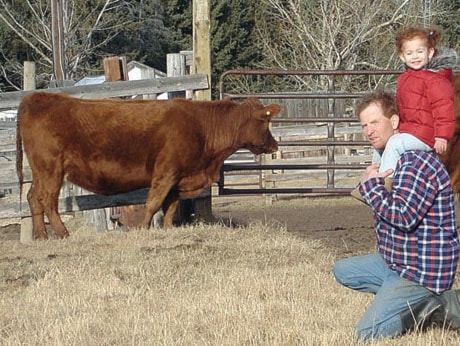Iain Aitken is donating more than $1,200 worth of beef to charity — but will only be out of pocket about $340.
Generosity wasn’t the only motivation behind the rancher’s action. He wanted to draw attention to the disparity between what producers are being paid for cull cows and the revenues that result when the meat hits store coolers.
Aitken, who raises grass-fed, antibiotic- and hormone-free cattle west of Rimbey, took a breeding cow that was well past her prime and had an abbatoir transform her into hamburger and stew meat. The 600-kg animal yielded $1,233 worth of meat, based on the prevailing prices at the Rimbey Co-op.
Had he taken the cow to auction, his return would have been around $340, said Aitken.
He wants to know who’s gobbling up the nearly $900 difference.
“The retailer tells you they’re using beef as a loss-leader, they never make money selling beef, so it must be the processor that’s making the money; and the processor tells you they’re losing money processing cows, so the retailer must be making all the money.
“We really need to get to the bottom of that, because until we do we can’t start to formulate any kind of sensible policy for the cattle sector.”
Aitken cited figures from the National Farmers Union that indicate producers were receiving about 24 per cent of the retail price of beef 10 years ago. Last year, their cut had dwindled to 16 per cent.
NFU regional organizer Jan Slomp, who also farms near Rimbey, has responded by calling upon the Canadian government to take action.
“We need to have a federal government investigation into the profits made in the beef processing and retailing sectors to identify how much is being made and by whom.”
The Alberta Beef Producers is also frustrated with the situation, said Rich Smith, general manager of the organization that represents 35,000 beef cattle producers.
“Certainly, we have concerns about the concentration of businesses in the processing sector and the retail sector.”
But, he added, there are no easy solutions. Smith has seen no evidence of collusion that might trigger action under Canada’s Compeition Act, and he questions the benefits of such an investigation.
“That isn’t going to create more competition, and our view is we don’t want the federal government looking into the profits of any business that’s law-abiding — whether it’s a farm, a ranch or a processor.”
The problem, he said, is the lack of competition.
The number of processors in Alberta and Saskatchewan has fallen from more than 20 a few decades ago to two.
“If there were 20 instead of two, I suspect that that would put upward pressure on prices.”
Similarly, added Smith, ownership in the retail sector has become more concentrated.
“We used to have far more retailers competing for the beef that came out of the processor.”
The Alberta Beef Producers is studying the issue, he said, but solutions will be tough to find regardless of the outcome.
The decline in the number of processors, and the fact those that remain are not operating at capacity, suggest the industry isn’t producing windfall profits, said Smith.
He also thinks cull cow prices have also been pushed down by other factors, such as high feed costs and the dairy cow retirement program in the United States.
Aitken doesn’t think a surplus of cows is to blame for the low prices. Packing plants have the capacity to process more, and the prices of hamburger and stew meat in stores have not decreased, he said.
hrichards@www.reddeeradvocate.com
